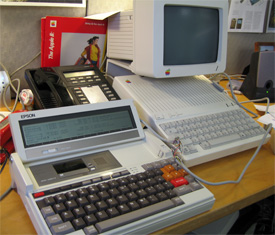Let me first say “no.” I am not in the process of transforming this retro computing blog of mine into Byte Cellar: All Things As Mac OS X Dumb Terminals. Honest!
But yes, I do seem to suffer from a woeful addiction. I admit it to you, my readers. (I can feel a weight lifted already.) And the undeniable evidence of this addiction? I’ve wired up yet another vintage system as a dumb terminal to Mac OS X. Hey — third time’s the charm, right?
First, a bit about the vintage system in question. Both of my regular readers may recall that about six months ago I was intrigued by what I heard of Earl Evans’ interest in and restoration efforts concerning one of the first laptop computers, the Epson PX-8 “Geneva” (circa 1984), on his Retrobits podcast. I remembered the unit well thanks to a review I read of it back in 1984 in an issue of Computers & Electronics magazine. In fact, I still had the magazine on hand so I dug it out and scanned in the review, along with a nice two-page Epson PX-8 advertisement. I was pleased to hear back from Earl who rather enjoyed having the review to read and let me know that new-in-box PX-8s were still available for purchase from Star Technology! And, of course, I did.
The PX-8 is a great little machine. It weighs 5 lbs, features an 80-character by 8-line LCD display with angle adjustment, is powered by a Z-80 compatible CMOS CPU, runs CP/M 2.2 out of ROM and runs for 15 hours per charge. It comes with several extremely basic apps on-board (including BASIC, actually), and additional programs can be added by way of pop-in ROM chips or via floppy, if you’re fortunate enough to have gotten your hands on an elusive FP-10 floppy drive. Epson sold the PX-8 for $999 back in its day.
I brought the unit in to the office some time ago to fiddle with occasionally during free time at lunch. I noticed it sitting there the other day, next to my Apple //c which acts as a dumb terminal tied to my MacBook Pro when it occurred to me that I had an oldschool Mac mini-DIN 8 serial cable tucked in a drawer here…and that the PX-8’s RS-232C port is likewise a mini-DIN 8…. After a few minutes of hunting down pinouts on the web and sketching out a crude null-modem signal mapping by hand I pulled out the Swiss Army knife and started stripping cable. I was at work and had no soldering iron on-hand, so it was twist, twist, twist and time to cross the fingers. I connected the PX-8 to my USB-to-serial converter, opened an 80×8 terminal window in Mac OS X, issued the magic commands and voila!
It’s not a particularly ideal terminal — I don’t believe the system’s terminal app is even VT-52 compliant. Like the eMate 300 I put through the same drill, I don’t picture the PX-8 being a permanent fixture in the office. But hey, it was a fun way to spend lunch!
I hope you enjoy the photos.


Interesting story I just ran across.
http://www.planetnz.com/palmheads/tandy.php?pg=dumb#dumb
A Tandy Model 102 laptop running as a dumb terminal to a modded XBOX running Xebian Linux. Sexy.
test
test test
Very cool! I’m tempted to buy one of these laptops myself. I’m listening to Retrobits right now and just listened to the show where Earl talks about the Epson PX-8.
Oooh, very nice, I’m going to have a go at this myself. I tried to view the scanned magazine article but the images could not be found, do you still have them?
aliennerd– Thanks for pointing out the dead link. (When I moved my images from my own server to Flickr, I never got everything updated.) I’ve corrected the link to the review scans in the other article. Here’s the direct link to the scans:
http://www.flickr.com/photos/blakespot/sets/72157604396164796/detail/
Pingback: Modern-Day BBSing on the Epson PX-8 CP/M Laptop, Circa 1984 | Byte Cellar